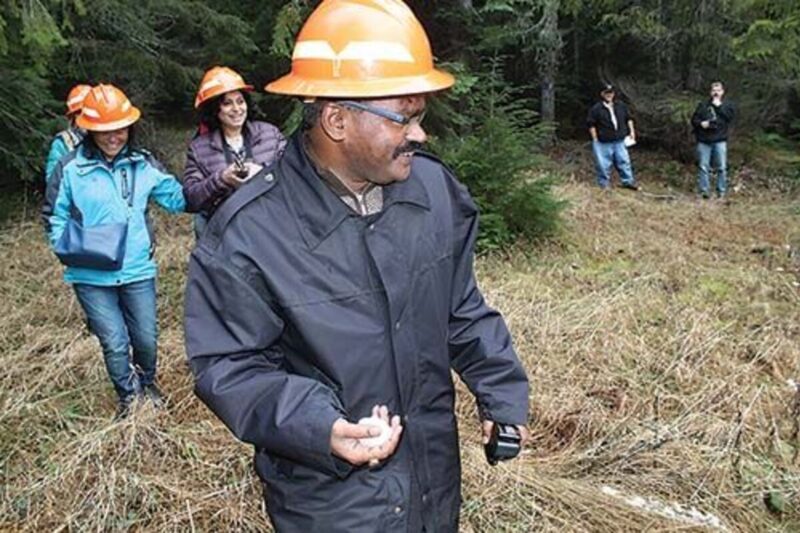Sean C. Morgan
Johan Hogervorst and Saibal Dasgupta have a lot more in common than they may have realized prior to last week.
Hogervorst, a U.S. Forest Service hydrologist who often works in the Sweet Home Ranger District, met Dasgupta Wednesday, Dec. 3, during a tour of the Soda Creek area by a group of foresters from India.
The seven visitors, who are all professional foresters, some with advanced degrees in the field, hail from all over the world’s seventh-largest nation, geographically, and its second-largest in population. They stopped Wednesday en route to Eugene to tour the Cool Soda All-Lands Restoration project, a collaborative effort between the U.S. Forest Service, Cascade Timber Consulting and the South Santiam Watershed Council that is focusing on the 10,000-acre Soda Fork drainage in the upper South Santiam River canyon.
They spent Thursday in the McKenzie River Ranger District before heading to their next stop – Costa Rica.
The tour was organized by India’s Ministry of Forests in conjunction with the U.S. Forest Services’ International Programs, which hosts foreign visitors who are interested in learning how the U.S. Forest Service operates. They were accompanied by several IP staffers from Washington D.C. and Portland.
During their field trip on Wednesday the visitors gathered around Ken Loree of the Sweet Home Ranger District in a high mountain meadow in the Soda Fork drainage as he explained the various goals in managing the meadow – for the development of early seral forest, huckleberries for area Native American tribes, fuel breaks and luring deer and elk from seedlings planted on nearby private timberland.
The Ranger District will do some burning and plant huckleberries and noble fir in the area to help meet those needs.
The area will provide a continual supply of boughs for wreaths periodically before being harvested in 40 years, Loree said. The changes will improve elk habitat, drawing them away from private land; and it’ll provide “first foods” to Native Americans.
Earlier in the day, during a stop at the Ranger District Headquarters, District Ranger Cindy Glick and others outlined how management of the national forests has changed in the last 25 years from “production” to a “Benefits from Nature” approach that emphasizes goods and services people receive from natural ecosystems in the forest – “a deliberate focus on outcomes rather than just outputs.”
That is the approach that has driven the formation of the Cool Soda All-Lands Restoration effort, which has attracted the attention of Duke University researchers and brought the Indian visitors to Sweet Home.
“We’re honored and flattered that you’re here,” Glick told the visitors. “It’s not too often we get Indian foresters here. We hope to learn as much from you as you do from us.”
The Indian foresters said they hope to take ideas back to India – and share what’s working in their forests.
“The world is a very knowledgeable village,” said Dasgupta, who is deputy director general with the Indian Council of Forestry Resources and Education. “That’s a vast resource to help improve forest practices, and some issues are global and concerns everywhere.”
Forest management in India is similar but also holds drastic differences, he and others said. Members of the forestry delegation described fragmented forests with numerous indigenous villages, which all share common use of the forests.
Forest managers protect those cultural uses, and they also protect the ecosystems. Like American forests, Indians are concerned about threatened and endangered species. Among them are rhinos, monkeys, leopards, panda bears, elephants, tigers and many more.
“If a tiger dies, the forest officer has to explain why it died,” Dasgupta said. “And the press will hound you.”
“You suffer from the same problems we do,” Hogervorst said, noting in the United States, some species evoke more emotions than others.
Indians deal with their forest pests too, like elk and deer. In India it’s deer and elephants.
“The idea is to understand what your people have done,” Dasgupta said. “Anything good we see, we try to implement in our forests.”
Most forests are more or less the same, he said. They face the same problems even if the species, the deer and the elephants, differ.
“We’re really enjoying every bit of it,” Dasgupta said about the trip.
”Wonderful. Wonderful people. Wonderful place, and I’ve enjoyed every bit of it. We’re learning, and we’re hoping to take back good practices and try to implement it in our system.”
– Scott Swanson of The New Era contributed to this report.





